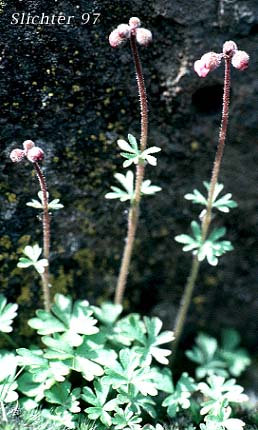 Smooth prairie stars from
scablands about 5 miles NW of The Dalles, OR....March 2, 1997.
Smooth prairie stars from
scablands about 5 miles NW of The Dalles, OR....March 2, 1997.
The USDA PLANTS Database currently has the species name spelled Lithophrgma glabrum. In addition, it has bulblet prairie star grouped as a part of this species.
Smooth prairie star is an attractive perennial with stems arising 5-25 cm from a cluster of small basal leaves. The stems and inflorescence are often purple-tinged in color, and the herbage is sparsely to thickly glandular-hairy throughout. The basal leaves are cleft to the base into 5 cuneate segments which are individually lobed. The basal leaves are smooth-surfaced to very lightly haired. With petioles, the basal leaves are from 1-2.5 cm long with blades from 1-2 cm wide. The 2-5 stem leaves are similar to the basal leaves, but reduced in size. They may bear several small reddish-purple bulblets within their axils. The bulblets may also be found within the inflorescence.
The inflorescence is usually a corymb or cluster of 2-5 flowers grouped closely near the tip of the stem (See photo of unopened flowers at right.). The flowers bear 5 white to pinkish-tinged petals, the blades cuneate-obovate, usually less than 8 mm long. The petals are 3-5 cleft, with each division further divided, often deeply, giving the petals a tattered look (See the photo atop of this page.). The calyx is cup-like, or broadly rounded at the base, and from 2.5-3.5 mm long in flower.
Smooth prairie star may be found on open, grassy and sagebrush slopes and in open ponderosa pine and oak woodlands.
Smooth prairie star may be found from Chelan and Kittitas Counties, Washington south along the eastern side of the Cascades to the Columbia River. Gorge, and hence south to south-central Oregon. It may be found eastward to northern Idaho, northwestern Montana, southeastern Washington, and northeastern Oregon.
In the Columbia River Gorge, it may be found between 100'-3000' on rocky outcrops near Crown Point east to near Horsethief Butte.